SUPER 7 STAMINA
Stamina Scale Synopsis
ALOHA!!!
I have complied a few random sections for you... 7 in total, of course. haha
These are taken from different days and sections from my online course, so hopefully it makes some sense. My entire program is approximately 400 sections of content, with the information being progressively and thoughtfully scattered, on purpose. Some of this information below might be a little out of order; hopefully, you'll be able to follow most of it. :-)
Training with heart rate methods are popular, but the Stamina Scale is a better solution for most individuals. If you want to use a dual approach, it would be interesting to know what your heart rate is for each number on the Stamina Scale below. For example, if you are at an 11 on the scale, what is your heart rate? At 15, what is your heart rate? Or, inversely, what is your "perceived exertion level" for every heart rate in increments of ten. In other words, what is your number on the scale (from 6-20) when your heart rate is at 80 beats per minute... and 90, 100, 110, 120, 130, etc. This isn't necessarily necessary, but it's extremely helpful information when designing a customized conditioning program.
In any case, enjoy listening to the audios below, and reading along, as well. I put a few of the "scattered sections" here for you all on this single page so that they are all in one place, and on one "non-login-able" link. haha
Each section is an excerpt taken from different portions of the program, so the continuity might be a little off. Get your brain in the game... and enjoy learning a little more about "Eccentrics in Stamina."
Aloha & Mahalo,
Doug :-)
Heart Rate vs "Hard Rate"
OK? Great! Let’s move on… let’s talk about measuring heart rate.
The Super 7 System in STAMINA incorporates training your brain to train your body. Rather than measuring “heart” rate during your workouts, you will be measuring “hard” rate during your workouts. In other words, how hard you ultimately work is determined by how hard the work feels. Your brain will make your decisions for you from now on… not your heart.
The Stamina Scale for the Super 7 System is based on the research of Gunnar Borg (a psychologist and psycho-physicist... hmmmm, kind of reminds me of one of my college professors). Anyway, Borg’s research on rate of perceived exertion during exercise qualified your level of mental perception to quantify your level of physical exertion. Basically, how hard you’re working is determined solely by how hard it feels like you’re working. It’s mental, but it really works. The Stamina Scale enables you to quickly and accurately rate your effort level for any type of cardio activity being performed.
You might be thinking, “perception is subjective… so how can a subjective psychological & physiological feeling be accurate?” Well, because your brain processes every single event occurring throughout your body as you exercise. A plethora of research shows a very high correlation between perceived exertion and numerable measurable metabolic and physiological parameters. That’s fancy talk for saying that it really works.
Trusting your feelings is definitely different than taking your pulse, but it’s unquestionably the smarter way to go.
Have you ever thought about a few of the problems associated with measuring heart rate?
- First of all, what if you don’t know how to correctly palpate your pulse? Do you? Are you sure?
- Also, do you realize that the formulas for heart rate training are really only estimates?
- Do you also realize that the formulas must change, not only as your age changes, but also as your fitness level changes?
- Do you realize that there are actually quite a few different formulas and that they keep adding new ones?
- Even if you have the right formula, what if you miscount the beats or make a miscalculation?
- What if you press too hard on the pressure receptors in your neck (called the baroreceptors) and accidentally slow down your heart rate during exercise? You’ve probably heard to press lightly, but how hard is too hard? I actually used to measure my pulse by putting my hand directly over my heart but everyone thought I was having a heart attack. So, I stopped doing that.
- And how do you measure your pulse while you’re running, or skiing, or swimming?
Alright, technology to the rescue, right? You buy a telemetry strap, put it around your chest, and it gives you a continuous readout on your watch… or the machine that you’re using. Or, you just use a machine that has a very accurate built-in device for measuring heart rate while you exercise, right? The machine even calculates your “fat-burning” zone and then automatically adjusts the intensity of the exercise to keep you within your specific target heart rate range. That “fat-burning” range isn’t all that it’s cracked up to be either. You burn a high percentage of fat in that range, but not very much fat.
Remember, I’ve owned tons of every kind of fancy cardio machine you can imagine and still have only rarely recommended that my clients use heart rate for targeting exercise intensity.
Knowing your heart rate can certainly provide you with good information, and it’s kind of fun to watch how it bounces around during a workout. Nonetheless, heart rate is usually not the best tool for quantifying exercise intensity.
For one, consider the millions upon millions of people who are taking medications for the specific purpose of changing the strength and the frequency of their heart’s contractions. For instance, hypertension is often controlled with beta-blockers, and lots of people are hyper and tense. So, these medications significantly slow down the rate at which the heart beats. It’s the doctor’s way of making sure that their patient’s heart doesn’t beat too quickly or too strongly, so that their blood pressure doesn’t rise too highly.
Think about it. Imagine that your target heart rate, which is scientifically calculated by one of these formulas, should be 149 beats per minute. During exercise, your fancy machine accurately measures that your heart rate is 133 beats per minute.
What does this mean? Are you not working hard enough? Or is your heart-slowing medicine overworking… or working like it’s supposed to? Should you push your heart to beat the additional 16 pumps per minute? Don’t bet your life on it.
Let your brain make the decision. Use your head’s perception instead of your heart’s deception.
In this situation, the Stamina Scale is a much more effective and safer alternative for determining correct exercise intensity. In most other situations, it is as well.
Plus, the Stamina Scale is very simple. No formulas. No calculations. For most people, it’s the perfect fit and, thankfully, one size fits all. It’s worth trying on… occasion, probably every occasion.
Finally... The Stamina Scale
Without further ado, I’d like to formally introduce you to the Super 7 System’s Stamina Scale. Trust me, there’s a lot going on behind the scenes, but I’m going keep it fairly simple and straight forward for now; after all, it’s still only Tuesday.
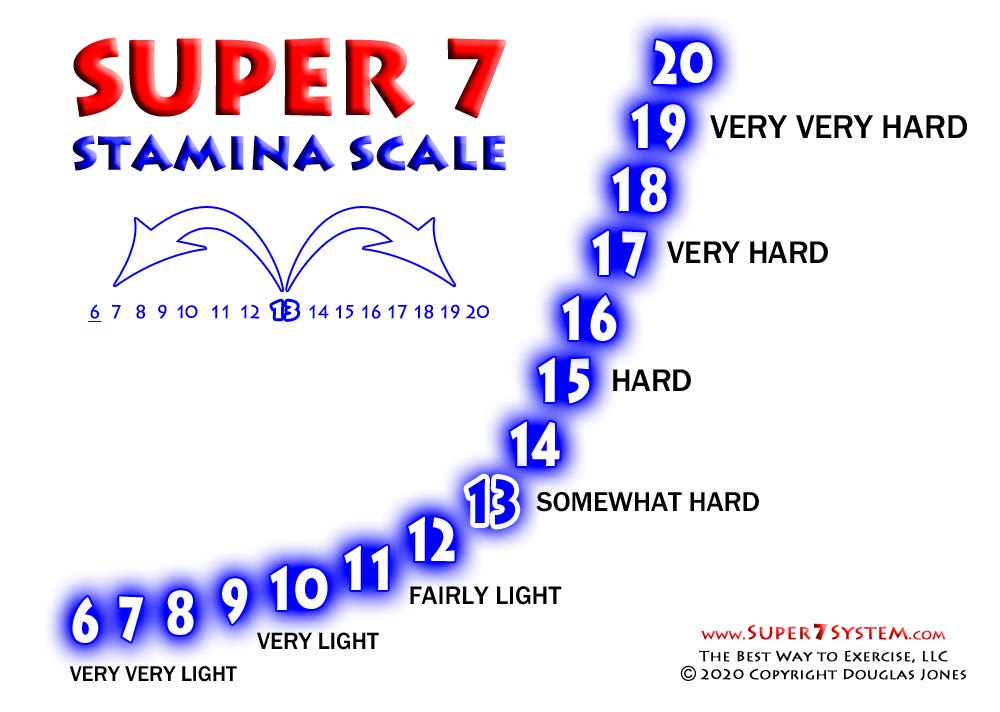
Basically, the Stamina Scale is a range of numbers from 6 to 20, which were originally intended to mimic an average adult’s approximate heart rate range from rest (around 60 beats per minute) to maximum exercise (around 200 beats per minute).
Every other number on the scale corresponds to a specific verbal description of the workload being performed. As a result, the Stamina Scale allows you to subjectively quantify your level of perceived exertion with both numerical and verbal indicators. In other words, you can now express how you feel during exercise with a single number.
Your rating should be based upon your perception of overall body effort and fatigue. View your body’s exertion level as an entire unit, not individual parts. Don’t focus on your legs or your lungs, or anything in particular… just be honest with yourself and let your body tell your brain, and then your brain tell your body, how you feel overall.
There is no right or wrong answer. Don’t try to be tough either. If you’re walking and it feels “very hard,” don’t pretend that it’s “fairly light.” There’s no need to be macho. Conversely, don’t try to talk yourself into your intensity being harder than it really is. Ask your body and your brain, “How does this feel?” and trust that you’ll get the right answer.
Also… be specific. Use decimals if possible. I actually think that you’ll be surprised just how accurately you can rate your internal intensity. Just listen to your body and try to best determine how hard it’s working. Trust your feelings.
On this Stamina Scale from 6 to 20, the number 13 stands alone as the CENTER of attention. Basically, exercising at an intensity rating of 13, or “somewhat hard,” allows you to engage in a fairly intense, prolonged activity without becoming totally exhausted. However, if you start to work just a little bit harder, and cross this threshold by going to 14 and beyond, you will most likely become fatigued within a matter of minutes or, for some of you, perhaps literally within seconds.

This pivot point of 13 falls exactly in the center of the 6 to 20 Stamina Scale, conveniently for me (perhaps because I designed it) 7 super steps from the bottom and 7 super steps to the top. Working at an intensity of 13 correlates strongly with a physiological phenomenon known as the “lactate threshold.” This is the threshold of lactic acid accumulation in the body (that metabolic waste product that causes “the burn” and indirectly causes fatigue).
Although your body is always producing lactic acid, right now, and even while you sleep, it’s not very much and your body has no problem metabolizing it. It is not until you cross over this “somewhat hard” barrier, around the number 13, that your body begins to have trouble getting rid of this acidic by-product of intense activity.
So, it should begin to make some sense to you now. Training lower on the scale (12, 11, 10, etc.) extends your exercise tolerability. The lower you go, the longer you can last. The activity feels relatively easy (because there’s no lactic acid accumulation) so you can keep exercising until you get physically bored or mentally exhausted. This is like walking for most people.
Training higher on the scale (14, 15, 16, etc.) is another story. Lactic acid builds and builds until you can no longer stand it or no longer move. This is like running for most people or, worse yet, like sprinting. The “burn” or fatigue, like it or not (and some people actually love it) will eventually force you back to reality… back under the pivotal number of 13. You can maintain an intensity above 13 for a while, but not forever.
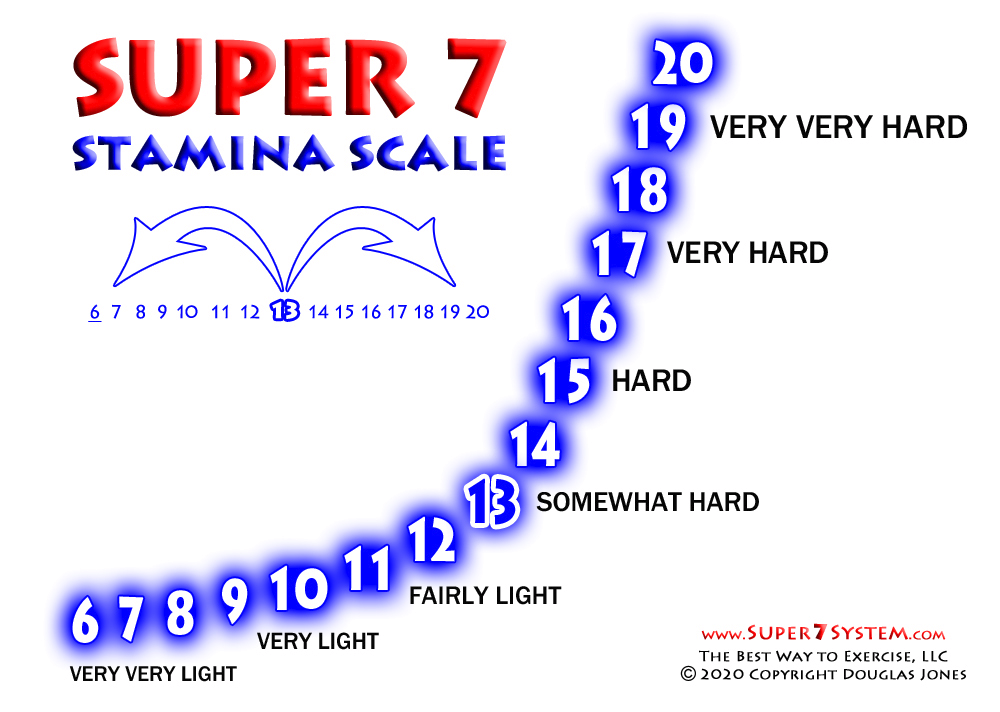
Everyone’s perception is personal, but everyone pretty much acknowledges 6 is asleep and 20 is a sprint, an all-out sprint; everything in between is somewhere in between. Every brain is different. Every body is different. And everybody is different. Each person is an apple and an orange, and you can’t compare them. It’s like compar…
So, what’s so exceptional about this lucky number 13? “Somewhat hard” on the Stamina Scale, regardless of how much work it takes each of us to get there, is the key threshold intensity. It’s the transition point from the two extremes: “this is a joke” to “you’ve gotta be kidding me.” It doesn’t matter who you are… age, gender, weight, former fitness level, current fitness level, mode of activity, or even environmental conditions… 13 is the number that you can hang your hat on.
If you’re overweight and under-conditioned, a leisurely stroll may be your number 13. As you get in better shape, it will take a little more effort to get there. Somewhat hard won’t be as hard as it used to be.
However, if you’re a competitive marathoner, you may have to run, uphill, to reach your number 13. And you might even like, or love, doing it. But if you take time off from running and detrain, you will reach 13 much more quickly with much less effort.

OK, so 7 steps from the bottom and 7 steps to the top. Coincidentally, and by design, and as I just told you, 13 is smack in the center of the Stamina Scale. This central axis point is the threshold of intensity recommended by many exercise physiologists, myself included, as the ideal training threshold for developing circulo-respiratory fitness. Who would have guessed? Super 7 to the rescue!!
So, how do you apply the greater training concepts of Eccentrics to the Stamina Scale? Using the unconventional “off-center” approach of Eccentrics, here’s the secret. Ready? Don’t train at the number 13. Yes, you heard me right. Don’t train at the number 13.
Instead, straddle it… off-center. Back and forth… side to side… see then saw. Perform a “very, very hard” and a “very, very light” workout simultaneously, with off-center intervals. If you do so, it is possible for your body to be working at 18 while your brain is only at 8.
By tricking your body, you’ll be rewarded by finishing your workouts almost before you start. The bigger the trick, the more brief the workout. And it should never, ever take you more than 7 minutes… unless you absolutely love to exercise and have lots and lots of time. If it takes more than 7 minutes, as you’ll eventually agree, you’re doing it wrong.
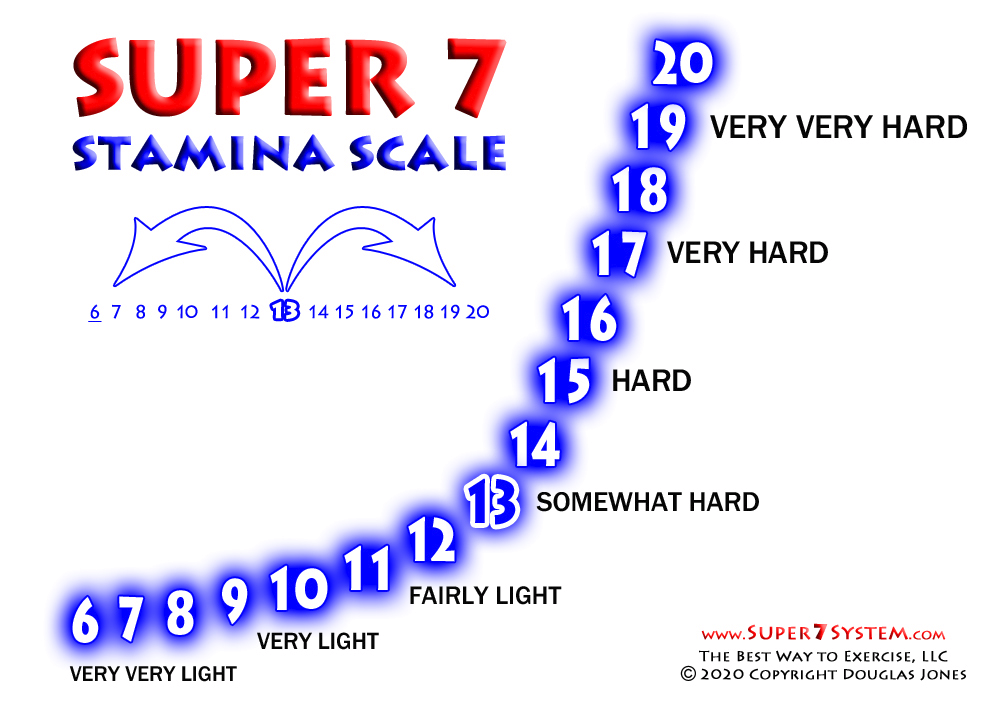
But today’s assignment is an easy one. While you’re doing your Stamina, or cardio, start by warming up and begin to tune into how you feel. Try to find your “center,” your number “13,” your “somewhat hard.”
Then, begin to adjust the workload on whatever mode of cardio that you’re doing… by changing the level, the RPMs, the incline, the pace, etc… and figure out how you feel. Increase the intensity a little. Decrease the intensity a little. Just try to find the middle of the stamina scale for you.
Also, you don’t need to worry about documenting that exact level, because it’s going to change depending how you feel at that exact moment. That’s the beauty of this. It accounts for everything that you’re dealing with at that specific moment in time because your body and brain are working together.
Then, after you’ve worked it out, trusting your feelings, and finding your center, it’s time for your brain to work out your body with off-center intervals. Go back and forth a few times. Up, then down. See, then saw. You can do this as few or as many times as you’d like for today, just so you get the hang of it. But I’m sure that you can guess how many times you’ll usually be Swinging the Stamina Scale, right? Super 7!!!
Let’s end with a few
blind faith tips for today;
I can elaborate another day.
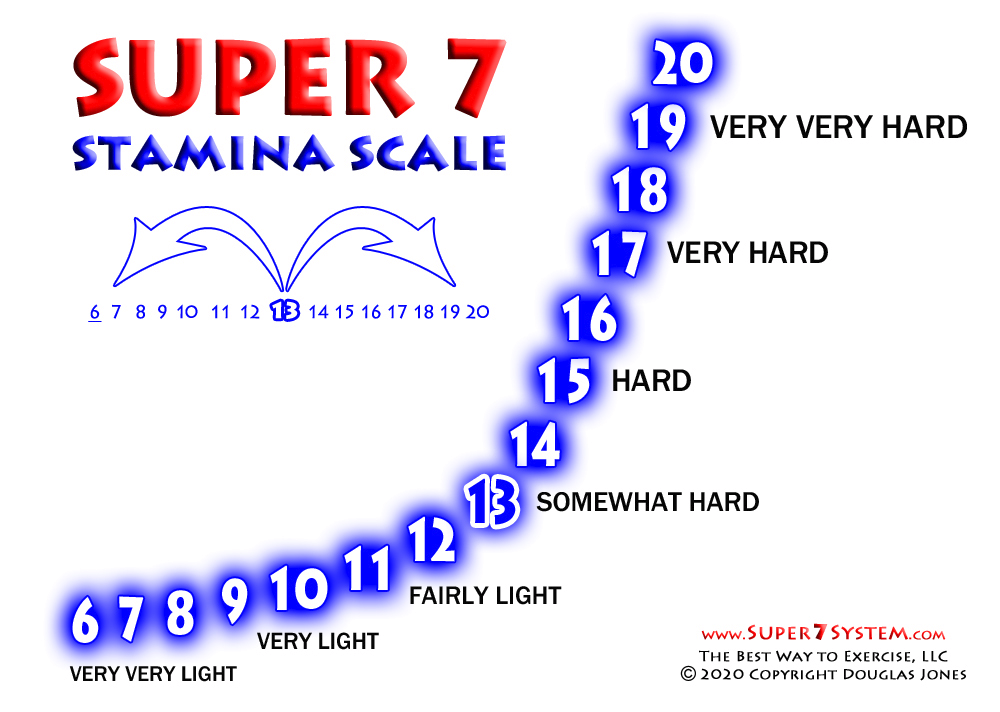
- Always start your sessions below the threshold of 13.
- Always end your sessions well below the threshold of 13.
- For now, keep the top end at the low end. In other words, 14 or 15 is plenty for now.
- Forever, keep the low end at the low end. In other words, 6 or 7 is perfect forever.
Butt Weight:
What About Fat Loss?
This is the section we’ve all been waiting for, right? If you’re like most people, I’m sure you have questions:
- How do I optimize the amount of fat I burn during exercise?
- How do I train in my “fat-burning” zone?
- Working at a low intensity really burns more fat, right?
Well, YES… it does. And, NO… it doesn’t. It depends on how you look at it.
The premise for the “fat-burning” zone all started with this scientific truth: the body uses a higher percentage of calories from fat during low-intensity work. During rest, probably right now, in fact, up to 80% of your energy is being provided via fat metabolism. But did you catch the key word or, should I say, symbol?
P-%-E-%-R-%-C-%-E-%-N-%-T
At lower intensities, the body uses a higher percentage of fat. This includes low intensity activities such as sleeping or watching television, or sleeping in front of the television; however, this also includes lower intensities of exercise.
Lower intensities of exercise burn a higher percentage of fat than higher intensities of exercise. Period. This is why the “fat-burning” zones that you see on exercise machines are at the lower end of the intensity chart. They’re all based on PERCENTAGE of fat burned. Yes, it’s all relative but, for fat loss, it’s VERY relative.
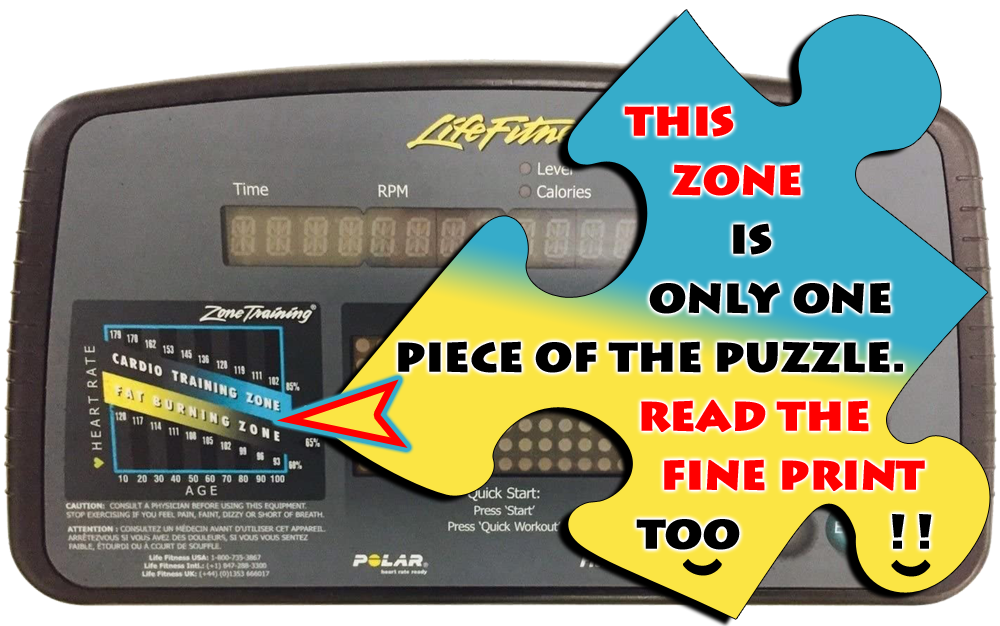
At lower exercise intensities, the body uses a higher percentage of fat and a lower percentage of carbohydrate for energy. As the intensity of exercise increases, the energy continuum shifts; the body gradually begins to use a lower percentage of fat and a higher percentage of carbohydrate.
So, it stands to reason that, at low intensities, when you’re burning a higher percentage of fat, you burn more fat then too, right? WRONG! In actuality, burning a high percentage of fat burns very little fat.
Otherwise, the least intense activities you could perform, sleeping and watching television, would be the ideal activities for fat loss. I hope we all know this is not to be true.
Sure, at low intensities, you burn a higher PERCENTAGE of fat… but you also burn a lower VOLUME of fat. So, try to follow me: at low intensities, you burn a higher PERCENTAGE of fat… but you also burn a lower VOLUME of fat.
Would you rather burn 100% fat at the rate of 50 calories per hour (with 50 calories of those being from fat) or 50% fat at the rate of 500 calories an hour (where 250 calories come from fat)?
Again... would you rather burn 100% fat (a high percentage) at the rate of only burning 50 calories per hour from fat? Or would you rather burn a lower percentage of fat (50% fat) at the rate of 250 calories an hour from fat?
OK, here’s the point. Although low-intensity exercise burns a greater PERCENTAGE of fat, higher-intensity exercise, exercise above the level 13 on the Stamina Scale, has a greater impact on fat loss because high-intensity exercise burns a greater total VOLUME of fat. In a nutshell, it burns more fat. Total number of grams of fat burned is actually higher with higher-intensity exercise because the total energy output is higher during intense activity.
This should make sense because it’s common sense. Think about it… I’ll say it again. The number of total grams of fat burned is actually higher with higher-intensity exercise because the total energy output is higher during intense activity.
Here’s my conspiracy theory:
I think that the “fat-burning” zones on exercise machines were a partial ploy on the part of the equipment manufacturers to con people into the idea that their machines could burn body fat without the person having to work too hard. Yes, you can burn some fat at these levels, but there are much faster ways to get the task accomplished.
Are you still with me? It’s all right if you want to start over at the beginning and go through this part again.
Let’s finish with a concrete example: a fat-burning comparison of an hour walk versus an hour run:
Walking for 60 minutes burns approximately 400 calories. Of these 400 calories, maybe 200 will be from fat (50%). So, during this hour walk, you’d burn 200 calories from fat. On the other hand, running for 60 minutes burns about 1000 calories (8 mph pace). Even if only 25% of these calories are from fat you still burn 250 fat calories. In addition to the 250, the other 750 calories you burn from carbohydrate must be replenished after the run. During this replenishment process, energy is used to “restock” the carbohydrate that was expended from the muscles and the liver, and glucose from the blood. Some of this energy also comes from burning more fat, bringing the total calories of fat burned from your 60 minute run to well over 250.
So, you’re looking at 200 calories of fat burned during a walk and, in the same time, over 250 calories burned from fat during a run.
And, because you're replenishing your energy stores during your recovery period, which occurs at a lower intensity, you’re doing so by utilizing a higher-percentage of fat. Additionally, during recovery, you’re working at a lower intensity with a higher metabolism, because you just completed an interval of higher intensity; therefore, you’re also providing more energy for your current workload, but at a lower intensity which utilizes a higher percentage of fat.
PHEW!!

OK, in a nutshell, you’ve basically cranked your metabolism to keep burning calories for a long time after you’ve finished the intense portion of your workout. Plus, you’ve challenged your circulo-respiratory and muscular systems to a much greater extent than you would have by only working in your lower-intensity, high-fat-percentage, yet “non-fat-burning” zone.
Remember, and let me make this crystal clear, it is highly preferable to do a low-intensity exercise than to do nothing at all. Also, on some days, like Sundays (your days of rest, at least from Eccentrics in Stamina), you may prefer to work at a slower pace. Or, perhaps you are required to limit intensity because of certain medical restrictions. If you need to stay in a lower-intensity zone for such a reason then, by all means, do so. Nonetheless, please keep in mind that, though you can always work out for longer periods, nothing will transform your body as quickly as 7 brief, intense swings on the Super 7 Stamina Scale.
Why Super 7 Stamina?
Eccentrics, the off-center training protocol of the Super 7 System for Stamina, provides you with the quickest form of cardio, the best technique for substantially improving circulo-respiratory fitness, and the ideal intensities for burning fat both during and after your workout. And it does all of this without requiring the measurement of heart rate.
The Super 7 System of Eccentrics in Stamina allows your brain to make the decisions regarding workload. Using your head’s perception instead of your heart’s deception, in most situations, is a much more effective and safer alternative for determining correct exercise intensity. In most other situations, it is as well.
An added benefit of the off-center system of Eccentrics is that you are able to rest in between each and every interval above level 13 on the Stamina Scale. It’s a lot easier to work at level 17 for a few seconds if you know that you are able to “rest” at level 7 for as long as you like. Most people don’t realize just how productive a few minutes of “on purpose” appropriately-paced cardio can be. The Super 7 System for Stamina is, without a doubt, the top secret to creative and constructive cardio.
If you looked at a wide variety of physiological parameters during sessions of Eccentrics in Stamina, you would agree and truly believe that you are, in fact, exercising for free. Yes… FREE EXERCISE!
Let’s say you really crank the intensity on your chosen mode of cardio and cross the target threshold of 13 (Somewhat Hard), blasting your way right to level 17 (Very Hard). It doesn’t matter if you are there for a second or a minute… you can do whatever your brain and your body want to do at the moment. The only rule is that you have to cross the threshold number of 13. Mission accomplished, and then some.
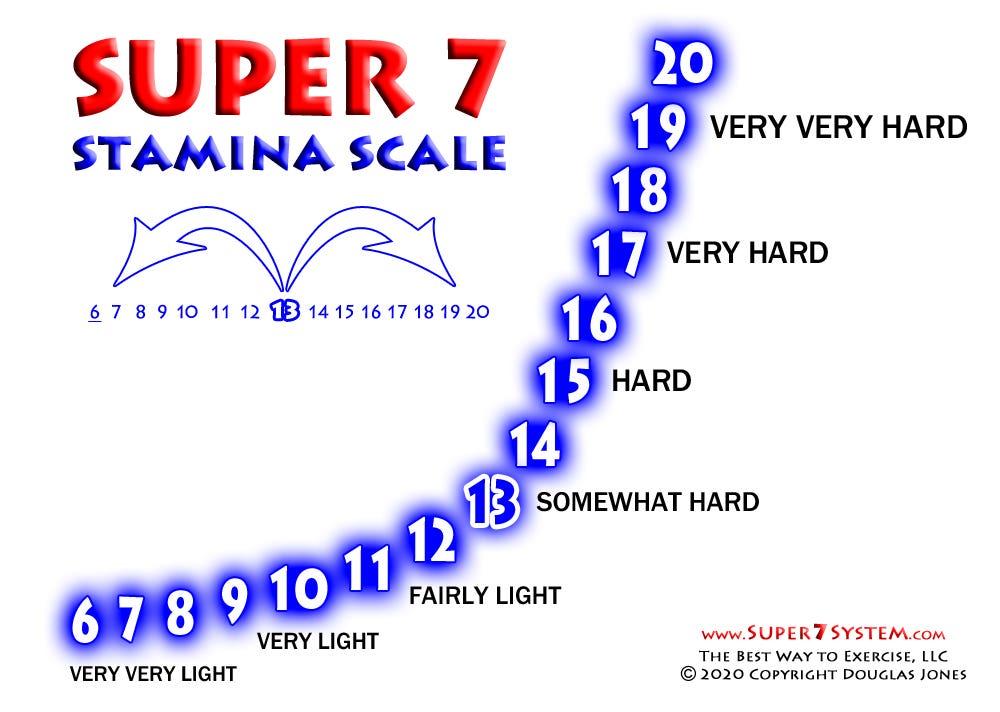
Now, when you reduce the intensity back down to a level of, say, 7 (Very, Very Light) on the Stamina Scale, your exercise will immediately feel like rest. However, although your brain is now at 7, your body is still at 17. And it will be there for a while. It may actually go up before it comes back down. You’ve created an oxygen and energy deficit, and now it’s time to repay that debt.
It really is amazing. For the duration of your rest interval, your body is basically getting the benefit of “free exercise.” You’re working hard, but it feels like you’re hardly working. And unless you have these easy workloads built into your program, you’d never be able to work so hard. This is the only reason I personally like to watch my heart rate sometimes during exercise. It’s fun to see yourself getting something for free.
Give it a try next time and you’ll see what I mean.
Weight: Words of Warning
The Super 7 System of Stamina, while a phenomenal answer for long-term fat loss, is also accompanied by the quizzical phenomenon of short-term weight gain. Let me be perfectly clear… gaining weight is a NORMAL, NECESSARY, & BENEFICIAL INITIAL SIDE-EFFECT of beginning a proper program of eating and exercise.
Now, if you don’t know why this is happening, you may be tempted to stop following the recommendations for long-term fat loss and go on some crazy low-calorie diet. So, you need to understand why you may gain this weight initially. Remember, it’s normal.
There are two primary reasons for an initial increase in body weight:
First of all, Stamina exercise causes quite a dramatic increase in blood volume. More blood allows for more efficient oxygen transport to the tissues. While the exact weight varies between individuals, increases in blood and blood plasma can account for at least a couple of pounds of weight gain. Remember, this initial weight gain is normal, necessary, & beneficial.
Not only is your heart beating much more efficiently with more blood volume, but this higher level of circulo-respiratory power and endurance allows your body to then burn a higher percentage of fat during all levels of physical activity. Increasing your level of circulo-respiratory fitness via Stamina results in each and every submaximal workload now being at a lower relative percentage of your new maximal capacity.
Does this make sense? Once you increase the maximal level of fitness, every other level below that is at a lower percentage of that new maximum. If your submaximal level is fixed at a certain intensity and your maximal level increases by becoming more fit, your new submaximal level is a lower percentage of your new higher maximum.
And since lower percentages of maximum burn higher percentages of fat, as you improve your level of Stamina, you’ll be able to burn a higher percentage and volume of fat for each and every level of activity and exercise, basically from rest to maximum.
Get it? Got it?? Good!!! I hope.
Another reason for potential and probably (and healthy) weight gain during the initial stages of an exercise program is due to the increase in the amount of glycogen in your body. Glycogen is a substance stored in your liver and your muscles and provides energy for your body during exercise. Glycogen is a storage form of carbohydrate.
It’s a good thing. It’s a great thing.
If you have been previously cutting calories or have been on some type of crazy low carbohydrate diet, which is often the typical American diet, your glycogen, or carbohydrate storage levels, will be low. When you start eating more carbohydrates (which I hope you are… like fruit, veggies, and whole grains) and exercising, you will gain weight because you are filling up the carbohydrates storage tanks in your body. This is normal; in fact, it’s great! But the process also requires a lot of water, almost three times as much water as the amount of carbohydrate being stored. This is one reason why it is very important that you stay well hydrated before, during, and after exercise.
So, if you do gain a couple of pounds initially, keep in mind that it is not fat. You are not getting fatter; your program is working as planned. You are just adding a little carbohydrate and water to your body, making your muscles maybe a little fuller and toned and giving you more energy for your activities.
Furthermore, fat cannot be burned efficiently unless it is in the presence of carbohydrate. Your body must be well supplied with carbohydrate if it is going to effectively burn fat.
Also, muscle tissue is more dense than fat tissue. As you increase your lean, fat-free muscle mass, you will become more dense; in other words, you will become more compact. Your body size will shrink as your density increases. You may look like you’ve lost 20 pounds while, in reality, you’ve only lost 10 (because you gained 10 pounds of lean and lost 20 pounds of fat).
Remember, muscle not only gives you tone, structure, and strength, but it also cranks your metabolism and helps you burn body fat 24 hours a day!!!
Speedy Stamina Summary

Stamina Scale:
A Series of 7 Swings
- Using the Stamina Scale, perform 7 swinging intervals, alternating between level 6 and levels 13+
- You only need to break the level of Somewhat Hard, or 13, for a moment before returning back to level 6, or Very, Very Light.
- You can stay at level 6, or Very, Very Light, until you feel recovered enough to perform another super swing.
- If in doubt, alternate 30 seconds each at level 6 and 13+ for 7 swings. This will take you a total of 7 minutes to complete.
- The upper limit of your Stamina Swings can gradually increase as you progress through your 7 intervals. For example, (if you are healthy enough to go past level 13) your 7 intervals can be performed as follows:
6… to 13 to
6… to 14 to
6… to 15 to
6… to 16 to
6… to 17 to
6… to 17 to
6… to 17 to
6... to Stop
These 7 Swings of Stamina can take you as little as 7 minutes to complete, plus or minus a few minutes for warm-up and cool down.
If you need to review some of the basic Stamina content from earlier in the week, please refer back to Tuesday, DAY 3. (Week 1: Day 3)
Step by Step
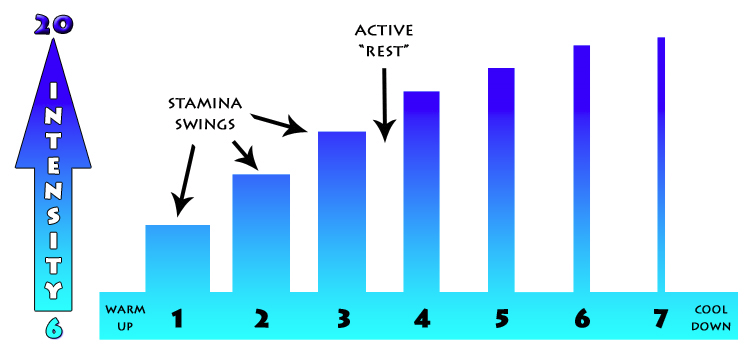
Each day this week, I will give you a different type of Stamina session to follow; so, I really want to make sure that you understand how to interpret the above chart, step by step. They may not be pretty, but at least they’re pretty simple. Just pay close attention to the blue columns; height represents intensity and width represents duration. And the white spacing in between the blue columns represents periods of Active “Rest” between intervals. “Rest” is in quotes because, even though you’re at the lowest intensity, you’re far from resting.
You will be introduced to a new Stamina chart each day this week, so it’s important that you fully understand the concept and their arrangement. In this example:
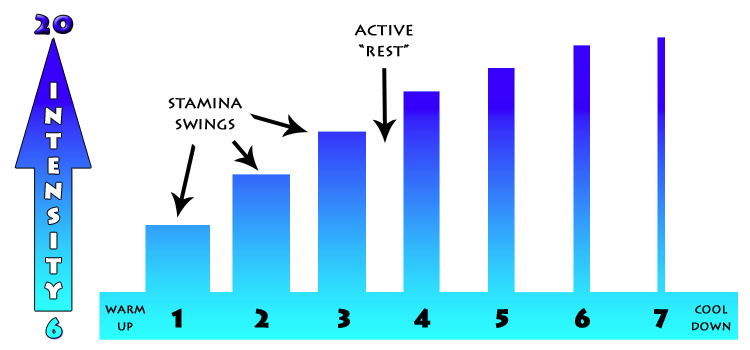
WARM UP: Always begin by gradually warming up for at least a few minutes at a low intensity.
SWING #1: The first Swing of Stamina should usually be at a moderate level of intensity. In this case, the first interval is actually less than half of your maximal level. This allows for a more progressive warm up and is appropriate if you are working out first thing in the morning or in colder temperatures, when you really need to warm up gradually. After working at the first Stamina Swing intensity for as long as you want (perhaps a minute or so in this example), then you recover with Active “Rest” at level 6 on the Stamina Scale (very, very light) for as long as you need (perhaps 20 seconds or so in this example).
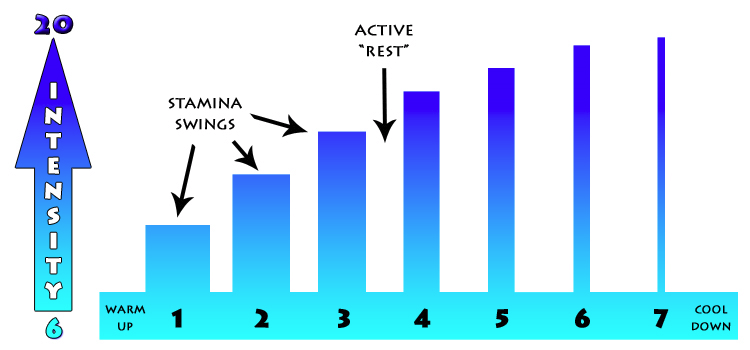
SWINGS #2-7 (Stamina Swings): With each additional Swing on the Stamina Scale (in this example), your intensity of exercise increases. As a result, the second is harder than the first. The third is harder than the second… and so on, with the 7th and final Stamina Swing being the most intense. Again, your personal maximal intensity does not need to be at level 20 on the Stamina Scale. Your maximal intensity may only reach 15 or 16… and that’s fine. It’s all relative.
Also, each Stamina Swing, though becoming gradually harder, should also become gradually shorter. If your first Swing is 60 seconds, your second might be 50 seconds… and so on, with the 7th and final Stamina Swing only lasting 5 or 10 seconds. In a nutshell, your next interval will be slightly harder and shorter than the current one.
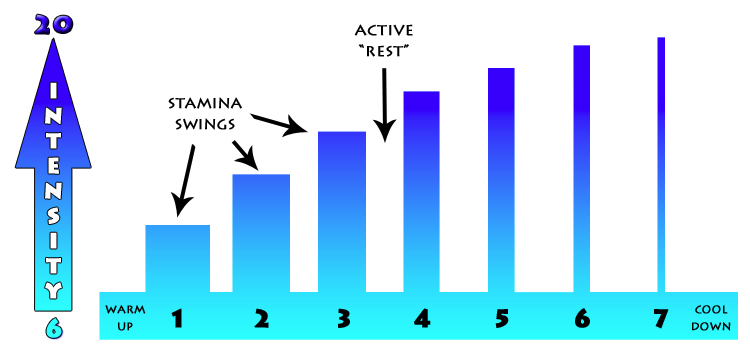
SWINGS #2-7 (Active "Rest"): As you progress through the 7 Stamina Swings, your periods of recovery, or Active “Rest,” become gradually longer (in this example). While you may have recovered for 20 seconds or so between Swings #1 and 2, you might recover for a full minute or two in between Swings #6 and 7. Because you are working at progressively higher intensities during the Stamina Swings, you are going to need progressively more rest in between intervals.
Also, as always, rest and recovery should be just that. I always recommend working at level 6 (very, very light on the Stamina Scale) during all periods of Active “Rest.”
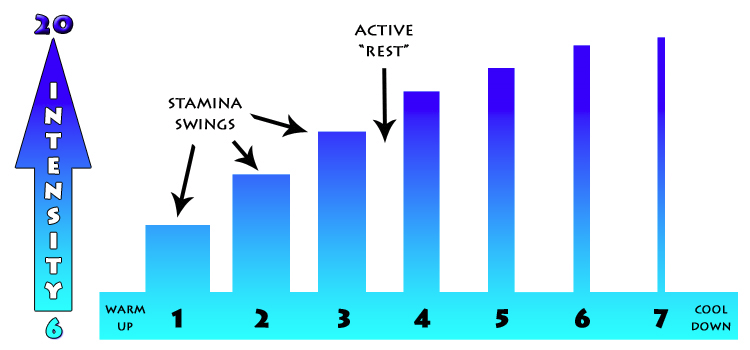
COOL DOWN: Your cool down is basically your final, though extended, period of Active “Rest.” It should ideally be for at least a few minutes in duration, until you are able to hold a conversation without laboring for breath. This is the one time that I recommend using heart rate to judge intensity. If your heart rate is not under 120 beats per minute, don’t stop yet. Not cool.

